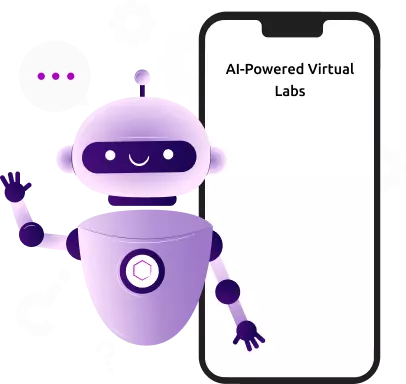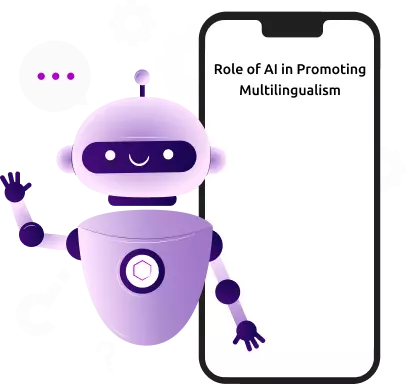- Our Writers
- How to Order
-
Services
Essays
Papers
- Why Us
- Resources
In today's interconnected world, speaking and writing in multiple languages is not just useful—it's really important. Being able to understand and communicate in different languages helps us connect with people from all over the world.
But sometimes, language can get in the way, making it hard to write or talk to others. This is where Artificial Intelligence (AI) comes in. AI is changing the game when it comes to language. In this blog, we're going to explore how AI is helping us break down language barriers in writing.
We'll take a closer look at how AI is making it easier for people to write and communicate in different languages, and why that's so important in our globalized world.
So, let's dive in and discover the exciting ways AI is reshaping the way we use language!
AI is transforming the landscape of multilingualism with its ever-growing significance in diverse industries. AI excels at processing data, recognizing patterns, and making quick decisions, all pivotal in overcoming language barriers.
AI has broad language applications, including translation (e.g., Google Translate), personalized language learning (e.g., Duolingo), and content generation via NLG technology.
AI language tools have come a long way, evolving from basic translation services to advanced models like Neural Machine Translation (NMT) and Natural Language Processing (NLP). These advances result in more accurate translations and better context-aware communication.
As we delve deeper into the world of AI and its role in promoting multilingualism, it becomes evident that AI is at the forefront of breaking down language barriers.
Here are some ways AI is helping in overcoming linguistic obstacles:
AI-powered language learning applications have the unique ability to tailor learning paths to individual learners.
By analyzing a learner's progress and preferences, AI adapts lessons and exercises to match their specific needs. This personalized approach not only enhances engagement but also accelerates language acquisition.
Many AI-driven language learning tools offer real-time feedback on pronunciation.
Learners can practice speaking in their target language and receive instant feedback, helping them improve their accent and fluency. This feature is invaluable for those looking to communicate confidently in a foreign language.
AI continuously assesses a learner's performance and tracks their progress.
This data-driven approach allows learners to see their improvement over time and identify areas that may require additional focus. It provides motivation and a clear roadmap for language proficiency development.
AI provides access to a vast array of language resources. Learners can explore diverse content, from news articles to podcasts, in their chosen language.
AI algorithms recommend content that aligns with their interests and proficiency level, making learning engaging and enjoyable.
AI-powered language learning apps are available 24/7, enabling learners to practice whenever and wherever they choose.
This flexibility accommodates busy schedules and ensures consistent learning, leading to better retention and skill development.
Some AI language platforms offer cultural insights and context alongside language learning.
This helps learners not only understand the language but also the culture, which is essential for effective communication and building cross-cultural relationships.
AI can connect learners with a global community of language enthusiasts.
They can practice speaking with native speakers, engage in language exchange programs. They can even participate in virtual language communities, fostering a sense of belonging and cultural exchange.
AI incorporates gamification elements into language learning, making it more enjoyable and engaging. Learners can complete challenges, earn rewards, and compete with others, creating a fun and motivating learning environment.
Incorporating these advantages, AI learning tools empower individuals to break language barriers effectively, fostering a more linguistically diverse world.
AI tools in multilingualism use artificial intelligence to break language barriers, aid language acquisition, and improve cross-language communication.
These versatile tools encompass various language-related functions that cater to the needs of multilingual learners, ensuring they can accomplish the following:
With these tools, multilingual writing becomes more accessible and efficient and opens up exciting opportunities for language learners and content creators alike.
Looking ahead, we can expect AI to keep making multilingual communication easier. New AI technologies will likely improve translation accuracy and enable more natural conversations in different languages.
We might even see AI-powered language tools becoming a standard part of our everyday lives, like smartphones. As AI gets better, it will continue to help us understand and speak various languages, making the world feel smaller and more connected. At the same time, people who work with languages, like translators and writers, will still have an important role, as AI can't replace the creativity and cultural insights that humans bring to language.
So, in the future, AI and humans will likely work together to break down language barriers and foster global understanding.

WRITTEN BY
Dr. Alex Mercer (Mass Literature and Linguistics, Masters )
Dr. Alex Mercer is a renowned author specializing in AI and academic writing, known for his insightful and informative blogs on EssayService.ai. With a passion for both technology and education, Dr. Mercer has established himself as a trusted voice in the field, providing valuable insights to students, educators, and technology enthusiasts alike.
Dr. Alex Mercer is a renowned author specializing in AI and academic writing, known for his insightful and informative blogs on EssayService.ai. With a passion for both technology and education, Dr. Mercer has established himself as a trusted voice in the field, providing valuable insights to students, educators, and technology enthusiasts alike.
On This Page On This Page
Share this article
AI-Powered Virtual Labs: Revolutionizing Science Education

How AI-Powered Writing Tools are Transforming Academic Writing

AI Writing Assistants: A Writer Best Friend or Worst Enemy?

CopyAI vs. EssayService.ai

Jasper vs. EssayService.ai

Rytr vs. EssayService.ai

Smodin vs. EssayService.ai

Ethical Considerations in AI-Generated Content

Future Trends of AI in Academics

The Impact of Artificial Intelligence on Education: Current Trends and Future Possibilities

Improving Your Essay Writing with AI: Tips and Strategies

Natural Language Processing in Academic Writing: Tools and Techniques

The Psychology of AI-Generated Content: How Do Readers Perceive It?

The Role of AI in Promoting Multilingualism: Breaking Language Barriers in Writing
